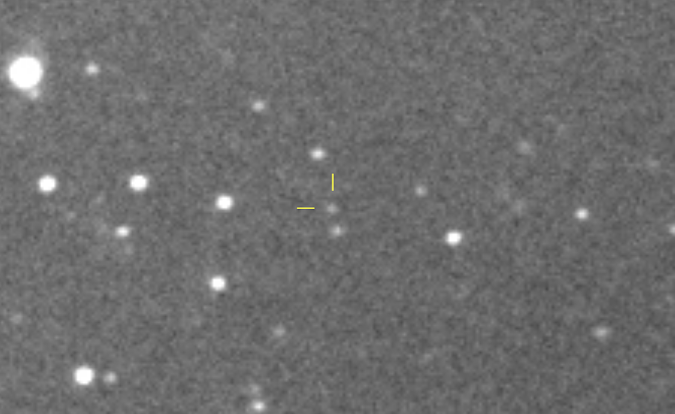Vend51 = AT 2023oom: a slow nova in the Andromeda galaxy
I've just found a 20 magnitudes bright extragalactic nova candidate on my 10x120s stacked images made with Luminance filter using a 0.51m telescope Utah Desert
Remote Observatory /UDRO/ at Great Basin Desert, Beryl Junction, Utah, USA
(iTelescope,net network) on 2023 August 5 09:02UT.
Co-ordinates: 00 46 52.59 +42 01 41.2 (J2000.0)
This slow nova has been officially designated as AT 2023oom and PNV J00465260+4201428 respectively. The VSX record of AT 2003oom (=Vend51).
Update on 26th September: recent spectrum made by Kenta Taguchi et. al. using the KOOLS-IFU attached to the 3.8-m Seimei telescope at Okayama Observatory, Kyoto University show that AT 2023oom (Vend51) is a slow nova.
Discovery image with reference images subtracted:
However AT 2023oom was not visible on reference images made with the 0.51m telescope at UDRO on the night of 31 January/1 February and before.
ZTF data mined out by Jingyuan Zhao suggest that this is a blue object, thus likely not an LPV but a possible slow nova.
Actually this nova candidate is located only 17.3' distance from M31N 2008-12a, thus the area might have been quite frequently monitored in the past decade. Maybe it would be worth to investigate archive M31N 2008-12a images for checking the past behaviour of Vend51 = AT 2023oom.
Update:
Precise
astrometry of AT 2023oom: RA = 00 46 52.62, DEC = +42 01 41.6
(residuals are 0.1”) made by Tonny Vanmunster, CBAT Belgium using his
0.40m f/10.0 SCT telescope and a QHY-286M CMOS camera with clear
filter, total exposure time 540s.
Photometry result: CV = 20.66 +/- 0.32.
Mid exposure time: 2023 08 10.053 UT.
Update 2.:
Astrometry and photometry performed by Jingyuan Zhao (XOSS Team, China), based on my discovery image:
00 46 52.59 +42 01 41.2 (J2000.0)
Photometry result: 20.1 CV
Date: 2023 08 05.38355 UT
Observatory: Utah Desert Remote Observatory at Great Basin Desert, Beryl Junction, Utah, USA
MPC: U94
Telescope: 0.50-m f/6.8 reflector + CCD + f/4.5 focal reducer
This photometry data is in quite an agreement with the ZTF data. Thus,
as it can also be seen on the unfiltered images made in the last few
nights by György Farkasréti, Tamás Tordai and Tonny Vanmunster respectively Vend51
has faded about 0.5 magnitudes since 5 August.
Update 3.:
The recent light curve shows, that AT 2023oom (=Vend51) faded approximately 0.5 magnitudes after the days followed the discovery, but since then it is gradually brightening with some waves. By the end of august this slow nova candidate reached 19.5 magnitudes. Hopefully the brightening will continue in the following weeks thus spectrum will be possible to be taken with large telescopes. Follow up observations are urgently needed!
Update 4. on 26th September: recent spectrum made by Kenta Taguchi et. al. using the KOOLS-IFU attached to the 3.8-m Seimei telescope at Okayama Observatory, Kyoto University show that in the spectrum of AT 2023oom (Vend51), narrow emission lines of Ha and Hb (whose FWHMs are ~ 440 km/s) are prominent. This object is likely a very slow nova in M31. Thus this star has finally be officially classified as nova on the TNS server.
Recent photomery show that in the light curve some waves with 0.3-0.4 magnitudes on a time scale of 2 days can be visible. Hopefully AT 2023oom (Vend51) will further brighten with at least some 1.5-2 magnitudes in the coming days/weeks/month. Thus further follow-up photometric observations are needed!







Megjegyzések
Megjegyzés küldése